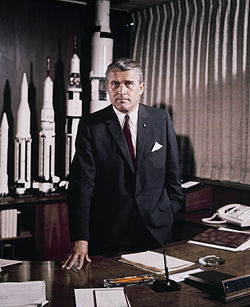The Mars Project
The Mars Project is a scientifically inspired book by the German rocket researcher Wernher von Braun from 1948. It describes the technical specifications for a manned Mars flight . It was first published in English in 1952.
Summary
The Mars project describes the technical requirements for a manned space flight and speculated in the first edition in 1948 with an actual rocket launch in 1965. The huge scientific expedition to Mars outlined by von Braun saw a fleet of 10 space vehicles (7 for passengers and 3 supply rockets , all of them should be assembled in orbit) and a crew of 70 men in total. Von Braun calculated the size and weight of the ships for the journey to Mars and back to Earth and calculated a fuel requirement of 5,320,000 tons.
Once in Mars orbit, the crew would use a telescope to identify a suitable landing site for the base camp near the equator. A manned aircraft would then enter the Martian atmosphere from orbit and slide there to one of the snow-covered poles, where it gently touches down on the snow. It was then planned to cover the 6,500 km journey from the pole to the planned base camp with a chain-driven vehicle and to create a landing strip there. The space flight comrades who remained in orbit until then would then fly down to the runway in their space gliders and join the pioneers. The astronauts would later leave Mars and return to Earth using the same gliders.
Reality reference
In the introduction to the book, von Braun explains that the description of the manned Mars mission has not yet been fully completed and that further details have to be clarified. Examples of the problems still to be solved would have to do with the orbit of Mars, the difficulties of interplanetary navigation , meteor showers and the effects of the long journey on the human body. Other aspects that von Braun was not aware of, and could not have been aware of in view of the available knowledge of his time in 1948, include the nature of the Martian atmosphere and the lack of density of the Martian air for a sliding descent from orbit, but also the exposure to cosmic rays . The Van Allen Belt , which protects the earth from this radiation, was only discovered later.
influence
The Mars project was the first time that a serious study on the requirements for a manned flight to Mars was published. Despite its incompleteness, the book is still seen today as a source of inspiration and as the most influential book for the history of the manned mission to Mars. In the United States, von Braun's ideas were subsequently taken up in popular scientific publications and made accessible to a broader readership. Wernher von Braun worked with Walt Disney , among others , and appeared in three TV episodes of Disney's Tomorrowland . Two other shows with von Braun were Man and the Moon and Mars and Beyond . Mark Wade writes in the Encyclopedia Astronautica , "What is astonishing is that von Braun's scenario is still valid today." (What is impressive is that von Braun's scenarios are still valid today.)
Source
- Wernher von Braun: The Mars Project . 2nd edition. University of Illinois Press , 1991, ISBN 978-0-252-06227-8 ( limited preview in Google Book Search - first edition: 1952).
Web links
- Book cover of the first edition on the English-language Wikipedia page
- The Mars Project publication history . Google Books
- 60th anniversary digital reprinting of Colliers Space Series , Houston Section of the American Institute of Aeronautics and Astronautics
See also
Individual evidence
- ↑ a b Von Braun Mars Expedition - 1952 in the Encyclopedia Astronautica , accessed on February 9, 2017.
- ↑ https://history.msfc.nasa.gov/vonbraun/disney_article.html


